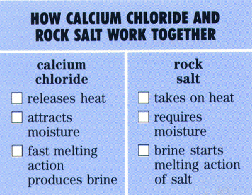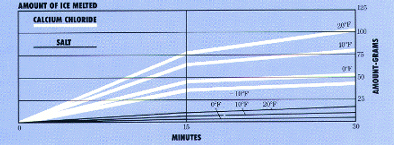- Spraying in the spreader truck Load rock salt into the spreader truck and drive it beneath a spray bar containing calcium chloride solution. You can then easily spray the amount of calcium chloride needed onto the salt.
- Spraying during application Spreader trucks equipped with calcium chloride tank/feeding systems allow fast and effective application of wetted salt. During application, the salt is wetted with the calcium chloride solution and spread simultaneously.
CALCIUM CHLORIDE VERSUS COMPETITIVE DEICERS ALONE
Rock Salt (Sodium Chloride)
- has substantially diminished effectiveness below
25F (-4C). The amount of ice melted per pound of rock salt drops 61%
from 30F to 25F. Rock salt alone:
- melts less ice in a given time period
- has slower melting action
- bounces and scatters off road (typically 30%)
- has greater neagtive environmental impact
Sand and/or Abrasives:
- does not melt ice and snow, just provides some traction
- bounces and scatters off road
- requires clean-up after winter

ADDITIONAL WINTER USES FOR LIQUID CALCIUM CHLORIDE
- Wetted abrasives: spray calcium chloride solution
on abrasives to help them embed quickly in ice and snow, save applications,
material, manpower, and equipment costs.
- Freeze-resisting stockpiles: spray 32% calcium chloride
solution on coal, sand, abrasives, limestone, wood chips, ores and minerals
as they are built into stockpiles to keep them free-flowing in winter.
Or spray entire stockpiles after they are built for the same long-lasting
protection.
- Thawing frozen stockpiles: restore frozen-solid
stockpiles to their original condition by adding calcium chloride solution
to the frozen masses.
- Similarly add liquid calcium chloride to rail cars to thaw out frozen material or coat empty rail cars to prevent freezing.
DEICING APPLICATION TIPS
When winter storms hit, correct application of pre-mixed or pre-wetted materials can make a difference in keeping roads in an easily plowable condition. They save valuable time in treating roads by preventing precipitation from bonding with the road surface. Application tips from road superintendents who use calcium chloride include:
- Get out early and use adequate amounts of road materials
throughout the storm.
- Don’t let ice build up under snow.
- Keep snow slushy and plow it off.
- Treat hills and intersections first.
Information About Calcium Chloride
 |
Calcium chloride outdistances traditional deicing materials to achieve safer, bare pavement — faster than salt or abrasives alone. Calcium chloride melts up to eight times as much ice as does salt alone — within the first 30 minutes at 20F (-7C) following application. Pre-mixed with salt and abrasives, calcium chloride becomes a cost-effective edge for winter road safety. |
- Exothermic: calcium chloride releases heat to activate salt’s melting ability.
- Hygroscopic: calcium chloride attracts moisture required for rock salt’s melting action.
- Fast acting calcium chloride begins to dissolve immediately upon application to break the bond between pavement and ice.
- Powerful calcium chloride brine remains active for prolonged periods of time to prevent ice from bonding to the highway.
- Low eutectic point calcium chloride melts to much lower temperatures than salt.
- Highway Safety: studies show that in 85% of applications, calcium chloride/ salt mixtures achieve bare pavement faster than salt alone at temperatures near 30F (-1C), to ease traffic and reduce accidents.
- Savings: calcium chloride increases salt’s effectiveness, therefore reducing the number of applications necessary during storms — saving manpower, equipment and material costs. Plus, it freeze-proofs abrasives to help them embed in ice and snow, so you lose less material to spreader bounce and traffic scattering.